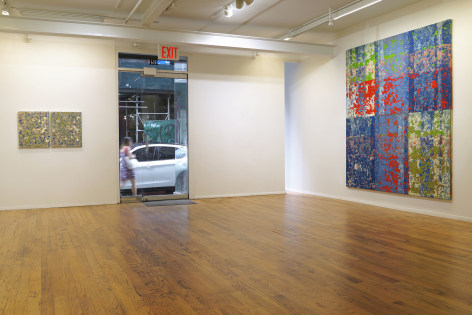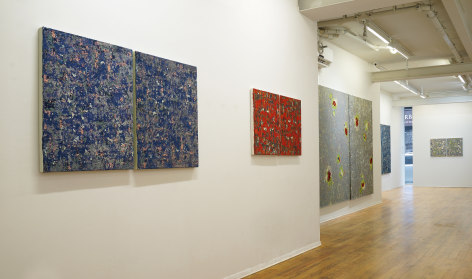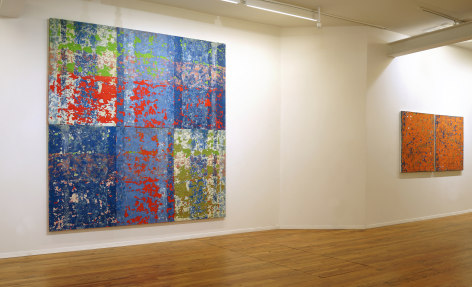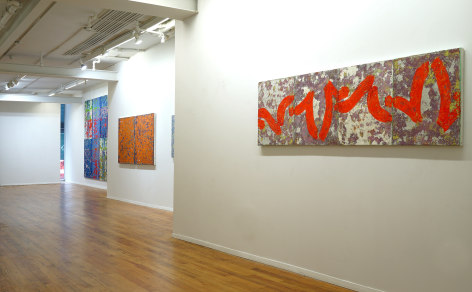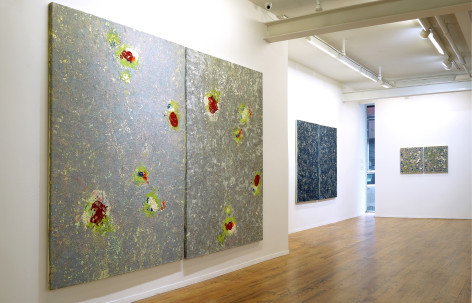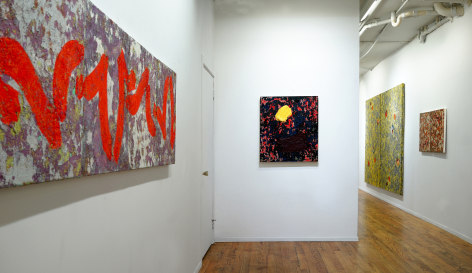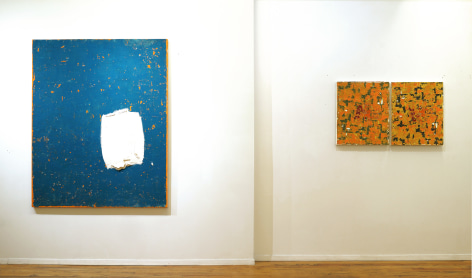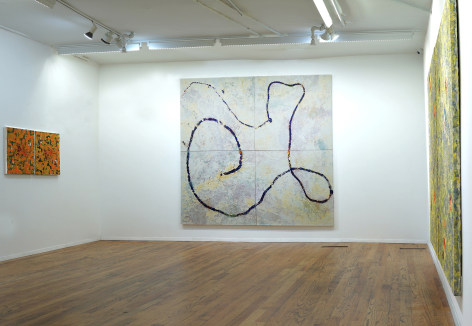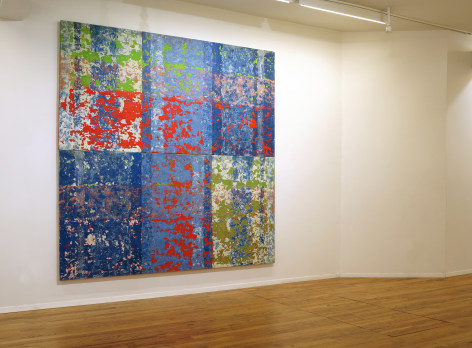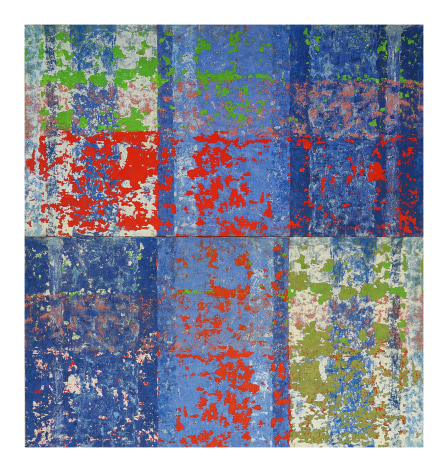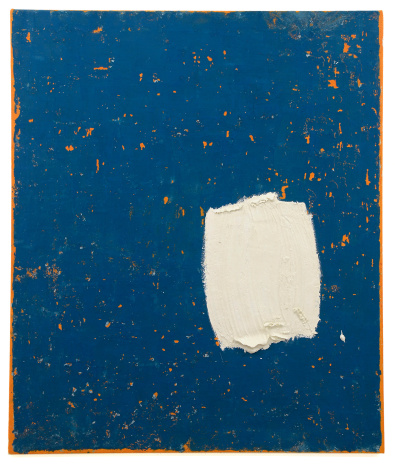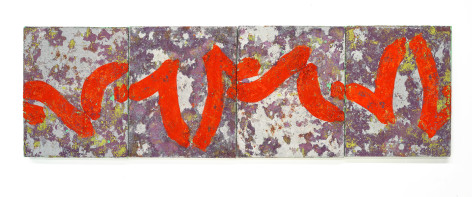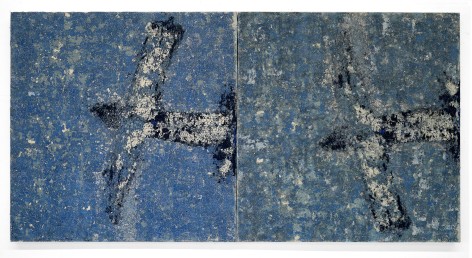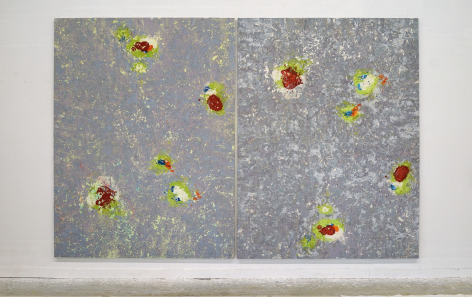Rainer GROSS Contact Paintings September 4 – October 26, 2019
Galerie Richard is pleased to represent Rainer Gross in New York and Paris and present his first show in the New York gallery titled "Contact Paintings" from September 4 to October 26, 2019. Galerie Richard has exhibited Rainer Gross in Paris in 1990 and 1997. The "Twin Paintings" and "Contact Paintings" are a definitive unique achievement by the artist in the history of painting. As their name implies, the compositions are two painted surfaces that the artist presents as a diptych, each panel imprinting on and mirroring the other. With the modesty of a philosopher, he admits that he controls the general composition but nature makes the details. This unpredictability is part of the everlasting fascination the viewers engage with these paintings.
"Gross' process is alchemic in nature. He first paints six or seven layers of different-colored pigments suspended in water on one canvas. These are neither a solid color nor a pattern, but each layer covers the last completely. He then applies an approximately 1/8-inch-thick layer of paint on another canvas of equal size, pressing them together by hand and leaving them to "cure". Gross then pulls the canvases apart, revealing the parts of the surface that have adhered to the other." This idiosyncratic technique produces a consciously unpredictable crackled impasto landscape that you can infinitely refer to other materials or textures altered by time. He hangs the double painting upside down, confusing the viewer by escaping obvious symmetries.
Understanding Rainer Gross paintings requests to recognize the challenge to become a painter in the '70s in Cologne, when the ideology of "The End of Painting" professed by Joseph Beuys and Associates at the Kunst Akademie Düsseldorf became a dominant ideology amongst the "elite" of the art world. Choosing to be a painter at that time meant thinking about the specificities of the medium, and the new ways to develop the history of the medium. From figuration to abstraction, Rainer Gross series shared one common point: they reveal every layer of paint and texture. From sticking kitsch canvases on his paintings, superimposing geometrical lines on figurative subjects, to the "Twin Paintings" and the "Contact Paintings", it has always been a play of visible superimpositions of various layers of paint.
The key difference between the new paintings is the importance of the process itself in the making of the work. The artist controls the original first painting. After that, it is altered by the pressure of the additional canvas which will take off part of the pigments in an unpredictable way. I presume it must be a wonderful feeling to discover a new creation which in many aspects did not depend on you and surprise yourself. The fascination for these works partly comes from the fascination for this unexpected and unpredictable part of the process, which brings a sense of infinity. In this aspect, it is interesting to associate Rainer Gross to some Asian contemporary artists such as Kiyoshi Nakagami, who never pretended as artists to have total control of the creative process and are happy to discover how natural processes interact in the final result.
Rainer Gross was born in Köln, Germany in 1951. He has lived and worked in New York City for 45 years. In 2017, Gross was included in the Beijing Biennale as a representative of Germany. In 2012, the Museum Ludwig (Koblenz, Germany) held a four-decade survey of his paintings. Other notable national and international exhibits include the Musée Cantonal des Beaux-Arts (Lausanne, Switzerland), Krannert Art Museum and Kinkead Pavilion (Champaign, Illinois), Kunsthalle Emden (Emden, Germany). Gross' paintings are housed in numerous public collections, including the AT&T Corporate Art Collection, the Cohen Family Collection, the Hirschhorn Collection, the UBS Union Bank of Switzerland, and the Lowe Art Museum. His work has been reviewed by the New York Times, Art in America, ArtNews, The Brooklyn Rail, The Boston Globe, and others.
Katalog essay: Rainer Gross, Contact Paintings– “Twins”
In the case of the paintings by Rainer Gross known as “Twins,” we are dealing with diptychs, i.e., two-part works which, when the two same-sized canvases are placed horizontally next to each other, yield an overall picture. At first glance, we encounter intense color and an enormous presence of the heavy application of layers of paint organized in flat planes. The spotty distribution of various colors conveys an impression of an organic proliferation of, say, colorful lichen, or of the weathering processes of the earth or other surfaces. Now and again, this assessment also applies to Gross’ paintings based on irregular strips of paint.
Despite these first associations, the works do not depict anything. Color and its appearances are what determine the works, and hence, they are unequivocally classifiable as non-representational color painting. But are we dealing with painting in the classical sense at all? No, and yes!
With Contact Paintings, Gross provides a term for his unique procedure that makes use of both classic artists’ oil paints as well as copious amounts of initially dry, actually powdery, color pigments. Particularly interesting in this respect is that the pigments are only bonded to become color matter once they have been applied to the canvas. This is accomplished by moistening the canvases with various liquids as well as by applying pressure, specifically by pressing the two sides of the painting together (“contact”), which Gross does by hand. This act is no less guided than the artist’s arrangement and layering of color when applying the powdery pigments.
Among the decisions Gross makes is determining how long the two sides will make contact. He defines this—in some respects alchemistic—process with utmost precision, deciding how long the liquids saturate the pigments and the extent to which he allows the overlaying paint to dry.
Finally, Gross separates the work’s two parts. It’s here that a kind of calculated chance becomes manifest as the painting comes about. Exactly which pigments or layers of paint detach is something that is, apart from the artist’s experience, only conditionally predictable. This ultimate moment of surprise is what the artist is looking for and savors, one in which for him—as in nature—the inherent dynamics exceed human control.
Taking a closer look at these paintings, we discover sensitive, delicate parts, subtle color compositions or perforations, and also an energetic, vehement tempestuousness, full of contrasts that seem like injuries. Areas of pastosely-applied paint are clearly visible, as well as grainy pigments, sometimes smooth, sometimes rough, and treated almost plastically. In a visual comparison of both parts of the diptych, we recognize their relatedness from their imprint procedure. Clumps of paint that adhere to one side as if they have been added are rendered as dents on the other side, for the most part drawing the gaze to the sediments beneath. This factor is mutually distinguishable. The two panels of the “Twins” are similar, but these are fraternal, not identical, twins.
In addition, Gross determines their arrangement in such a way that one half of the painting is, more often than not, turned 180 degrees. He provokes us to contemplate the two parts’ relationship to each other, since a dependence is obvious, though its deciphering is not directly apparent. No one side is the printing block; no one side is the printed result. Both sides are both. In the most literal sense, they have mutually created each other under the artist’s guiding hand.
Only once we have the key does it become clear to us that, with respect to the paintings’ effect, the genesis of these paintings, and their destruction, i.e., the “injuries” to the painted surface, are simultaneous. As with all creatures and things, the demise is inherent in the genesis. In this regard, in his paintings, Gross creates a memento morifor paint.
Of course, these are not injuries in a literal sense. Rather, the bulges of paint are to be interpreted aesthetically, like the openings of the picture surface in works by Lucio Fontana (1899-1968), or the traces in artworks made of torn-off posters, such as those by Raymond Hains (1926-2005). Gross was weaned on such positions in the avant-garde art scene in 1960s Cologne. He was similarly confronted, for example, by paintings full of color contrasts by the likes of Clifford Still (1904-1980) and other representatives of American Expressionism, when he settled in New York in 1972, making it his primary residence. This art historical system—up to the dynamics of tachistic placements—is something Gross also invokes associatively in his works.
His native Cologne and his adopted New York home also perhaps fueled the artist’s dialogue with the theme of the diptych. Immediately prior to beginning his work on the Contact Paintings, he rendered the twin towers of the Cologne Cathedral, an inscribed symbol of home for all Rhinelanders, in an abstract painting from 1996 called “Colonia Twins.” And for decades, the towers of the World Trade Center in Manhattan, the “Twin Towers,” were a landmark in the New York metropolitan area. Gross gives his “Twins” last names as titles: for example, “Schmidt Twins,” or “Elder Twins.” These were selected blindly from the New York telephone book. By using such random names, he releases the works from his care to their own existence. Here as well he emphasizes the autonomy of his artifacts, which have created themselves mutually during their process of origination, as described above.
Unlike positions in analytic color painting, such as those in works by Marcia Hafif (1929-2018) or Joseph Marioni (b. 1943) (who, for example, primarily question painting in pure self-reference concerning its parameters, the nature of the picture carrier, the character of the color material, and the technique used for paint application in relation to light and space), Gross succeeds in delivering a synthetic approach to color painting by evoking associative and narrative levels of meaning, in addition to analyzing the medium of painting and the painting process.
Michael Schneider

